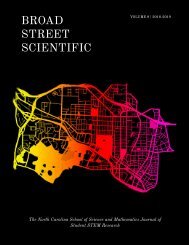Broad Street Scientific Journal 2020
Create successful ePaper yourself
Turn your PDF publications into a flip-book with our unique Google optimized e-Paper software.
QUORUM QUENCHING: SYNERGISTIC EFFECTS
OF PLANT-DERIVED COMPOUNDS ON BIOFILM
FORMATION IN VIBRIO HARVEYI
Preeti Nagalamadaka
Abstract
Sixteen million people die annually due to diseases caused by antibiotic resistant bacteria, sixty-five percent of which form
biofilms. Biofilms offer one thousand times more resistance to antibiotics with their exopolysaccharide matrix. Many bacteria,
including Vibrio harveyi, a model for Vibrio cholera, opt for this structure to evade antibiotics. Because biofilm matrix
production is regulated by quorum sensing, efforts are underway to find quorum quenchers. This project focused on testing
combinations of plant-derived quorum quenchers that function by different mechanisms to find if they were more effective
than individual compounds at inhibiting biofilm formation in Vibrio harveyi. In previous literature, neohesperedin
and naringenin were found to inhibit HAI-1 and AI-2 signaling. Cinnamaldehyde also disrupted the DNA-binding ability
of the regulator LuxR. V. harveyi biofilms were grown in the presence of quorum quenching compounds with dimethyl
sulfoxide as a control, stained with Crystal Violet and quantified by OD. Naringenin alone was found to decrease biofilm
formation, whereas cinnamaldehyde and neohesperedin alone showed no detectable effect. Combinations of naringenin
and cinnamaldehyde showed a synergistic effect on inhibiting biofilm formation. Through studying V. harveyi, optimized
quorum quenching could be utilized to counter V. cholera and other biofilm-spread diseases.
1. Introduction
To conserve energy, bacteria coordinate metabolically
expensive activities through quorum sensing. Small
amounts of bacteria bioluminescing are metabolically
wasteful because it will not produce significant light, but
a large group of coordinated bacteria bioluminescing simultaneously
has an ecologically stronger effect, conserving
energy and benefitting all bacteria. Bacteria use chemical
signals to communicate with each other and induce
changes in the bacterial population. When there is a high
cell density of bacteria, molecules called autoinducers are
produced. Upon reaching a threshold concentration, the
whole bacterial population is signaled to alter its gene expression
in unison – a process called quorum sensing [1].
Autoinducers collectively control the activity of metabolically
expensive bacterial functions such as biofilm formation,
pathogenesis, bioluminescence, conjugation and
secretion of virulence factors [1]. In many species such
as Pseudomonas aeruginosa, Helicobacter pylori, Vibrio fischeri,
Vibrio cholerae and Vibrio harveyi, quorum sensing is a
means for bacterial survival and host pathogenesis [1][2].
Some bacteria use a single type of autoinducer in quorum
sensing, usually acyl homoserine lactones (AHLs) or
autoinducing peptides (AIPs) [3], while others use many
types of autoinducers. The single autoinducer LuxIR system
is common in many pathogenic gram-negative bacteria,
but the systems present in V. harveyi, P. aeruginosa and
V. cholerae differ because they have multiple components
and autoinducers. V. harveyi respond to three different
autoinducers (Fig. 1): V. harveyi autoinducer-1 (HAI-1),
Cholera autoinducer-1(CAI-1), and Autoinducer-2 (AI-2)
[4]. HAI-1 is a homoserine lactone (HSL) N-(3-hydroxybutanoyl)-HSL
which is a type of AHL. CAI-1 is a 3-hydroxytridecan-4-one,
and AI-2 is a furanosylborate diester
[4]. AI-2 is found in quorum sensing pathways among different
species and is thought to contribute to interspecies
communication. HAI-1, CAI-1, and AI-2 are recognized
by the sensor kinases LuxN, CqsS, and LuxQ/P respectively
[4]. The low concentration signal is received at these
receptors and is transduced by the phosphorylation phosphotransferase
LuxU which then phosphorylates LuxO
[5]. This activates the transcription of small regulatory
RNAs (sRNAs) that prevent the translation of LuxR [5].
The LuxR protein then goes on to regulate the expression
of over hundreds of genes involved in biofilm formation,
virulence factor secretion or bioluminescence. At
higher concentrations of autoinducers LuxN, LuxQ, and
LuxP switch to phosphatases, dephosphorylating LuxO.
Since dephosphorylated LuxO is inactive, no sRNAs will
be formed and thus the LuxR mRNA will be stable and
translated [6].
The quorum sensing pathway was first observed in
the bioluminescent species V. harveyi and is responsible
for regulating its bioluminescence, colony morphology,
biofilm formation and virulence factor production [7].
Biofilms are communities of bacteria stuck to a surface
encapsulated in an exopolysaccharide matrix. The gene
responsible for the production of this matrix is regulated
by the LuxR protein. Due to their exopolysaccharide
coats, bacteria from biofilms can evade the host immune
system and survive longer in harsh environments, leading
to critical economic problems and nosocomial infections.
Because quorum sensing is integral to the survival of bio-
18 | 2019-2020 | Broad Street Scientific BIOLOGY




